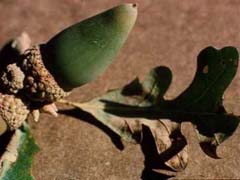Valley Oak
Quercus Lobata
Family: Fagaceae
Podcast Script
Valley Oak Whole Tree |
Valley Oak Bark |
Valley Oak Leaf |
 Valley Oak Acorn |
Classification:
Angiosperm, Dicot, deciduousSize:
The valley oak is a large tree with the heights ranging from 75 to over 100 feet in a mature tree. The trunk also reaches a width of 6 to10 feet.Identifying Features:
The valley oak has many unique characteristics that make it easier for identification. The leaves are a dark green with a felt-like texture. The undersides are pale green with yellowish veins. The leaves that vary in size from two to four inches long have deeply lobed sides that is usually a dead giveaway that the oak is a "valley oak". The bark has a rippled effect and is a pewter color.Location/Habitat:
The valley oak is native to the the main central vally and coastal ranges of california. It can only naturally be found in this area.The Valley Oak needs to be in an area of constant water. Though it is is a very versatile tree. it can live under numerous conditions. Some Areas where it can be found are dense riparian forests, open foothill woodlands, and also valley savannas. Areas that get intense sunlight and underground water are perfect for the Oaks. Thes root systems of the tree stretch far down into the ground searching for water.For a map of where the Oaks are present in California Click Here
Flower/Fruit/Reproduction:
The Valley Oak produces a flower and a fruit. Valley oaks flower with the arrival of spring. The flowers are monoecious and are in the axils of leaves of the twigs. They are wind polinated so the flowers are not showy. The fruit of the Oak the acorn. The acorn of the valley oak is small, about one to 2 inches long. This fruit is a favorite among the grey squirrel and other small animals.Water/Sun Requirements:
The oak can survive in many conditions but is at its best when there is a plentiful of water. Its long roots, sometimes as deep as 60 feet into the earth collect as much water as it can. The valley oak produces best under intense sunlight, hence the favorable habitat in an open savanna. The immense size of the oaks gives then a lot of surface area for the sunlight to hit and be absorbed by the foliage for photosynthesisSpecial Adaptations:
The Valley Oak is adapted to the climate of the central valley of California.Other Info:
One special feature that the oak has is that on the end of many branches are globular galls that house the larvae stage of wasps. The valley oak is important in the wasp life cylcle. These galls are sometimes mistakenly thought of as fruit from the tree when they are actually parasitic to the tree.The Yuri indians used Quercus lobata in the treatment of diarrhea.
Reference Sources/Links:
http://www.cnr.vt.edu/dendro/dendrology/syllabus/factsheet.cfm?ID=461http://www.laspilitas.com/plants/562.htm
http://www.efloras.org/florataxon.aspx?flora_id=1&taxon_id=233501056
http://en.wikipedia.org/wiki/Valley_Oak